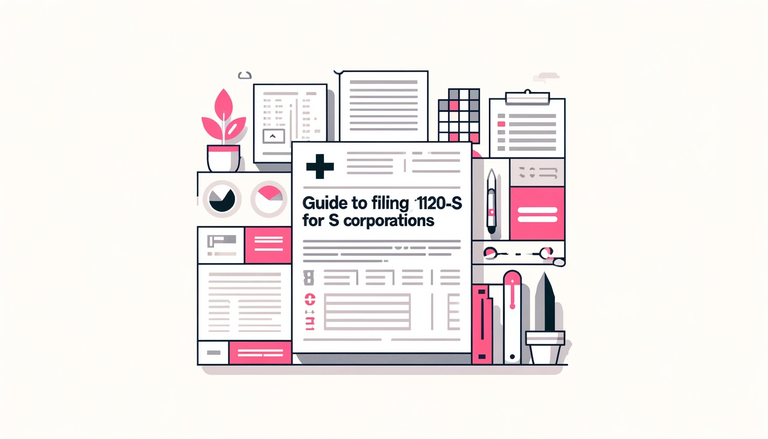Filing tax return for an S corp: Form 1120-S instructions

Filing taxes as an S corporation in the United States requires meticulous attention to detail and a deep understanding of specific IRS requirements.
Form 1120-S is the cornerstone of this annual financial reporting, serving as an S corporation's US income tax return. This form not only ensures compliance with federal tax obligations but also plays a critical role in how income and losses are passed through to shareholders.
Properly filed, Form 1120-S can help maximize tax efficiency and minimize liabilities for both the corporation and its shareholders.
Understanding Form 1120-S
What is Form 1120-S?
Form 1120-S is used by S corporations to report their annual income, gains, losses, deductions, and credits to the IRS. The form facilitates the pass-through taxation unique to S corporations, where income is taxed at the individual shareholder level rather than at the corporate level. This approach avoids the double taxation commonly associated with C corporations.
Eligibility requirements for filing as an S corporation
To file Form 1120-S, a corporation must be registered as an S corporation, a designation that involves meeting certain IRS criteria, such as having only eligible shareholders (e.g., individuals, certain trusts and estates, but not partnerships or corporations) and no more than 100 shareholders.
In addition, the corporation may have only one class of stock and must be a domestic corporation.
Key components of the Form 1120-S
The form has several parts that track different aspects of the corporation's financial activity:
- Income and deductions. Reports the corporation's financial transactions.
- Schedule K. Summarizes the shareholders' shares of the corporation's income, deductions, and credits.
- Other schedules. Provide additional details about assets, loans, and other financial matters.
Required documents and information
Preparing to file Form 1120-S requires gathering a variety of documents and information:
- Financial statements, such as income statements and balance sheets.
- Complete records of income and expenses.
- Documentation of shareholders' equity and distributions.
Form 1120-S step-by-step Instructions
When preparing Form 1120-S, follow these streamlined steps to ensure thorough and accurate filing:
- Basic information. Enter the legal name, mailing address, and Employer Identification Number (EIN) of the corporation.
- Income. Enter gross receipts or sales, subtract returns and allowances, include the cost of goods sold (if applicable), and document any other types of income.
- Deductions. Include expenses for salaries and wages (excluding shareholder salaries), repairs and maintenance, rent, taxes and licenses, interest and depreciation (attach Form 4562 if applicable), and employee benefit programs.
- Taxes and payments. Calculate taxes based on taxable income, detail estimated tax payments and any overpayment from the previous year, and determine if there's a refund due or an amount owed.
Tax calculation and reporting
- Pass-through calculation. Because S corporations pass through their net income or loss to shareholders, it's important to accurately calculate each shareholder's share of the income or loss. This information is reported on Schedule K-1, which is filed with Form 1120-S and provided to each shareholder for his or her personal tax return.
- Special deductions and credits. Take advantage of special deductions, such as the Qualified Business Income Deduction, which allows shareholders to deduct up to 20% of their business income on their personal tax returns, subject to certain conditions.
- Tax payments. If the corporation owes taxes (for example, on certain built-in gains or excess net passive income), ensure that these taxes are paid when due to avoid penalties and interest.
Understanding the Form 1120-S Schedules
Schedule K is a central component of Form 1120-S and provides a detailed summary of the S corporation's income, deductions, and credits that flow through to each shareholder. This schedule is crucial for both the S corporation and its shareholders as it directly impacts their individual tax returns.
- Schedule K summarizes the S corporation's financial activity that affects the shareholders' tax liabilities. It includes various types of income such as ordinary business income, rental income, and portfolio income, as well as deductions like charitable contributions and foreign taxes paid. Each line on Schedule K is designed to match corresponding lines on the shareholders’ individual tax returns where these items are reported.
- Schedule B on Form 1120-S primarily deals with questions regarding the S corporation's tax status and certain activities. It includes queries about the corporation’s stock ownership, accounting methods, and investment income, among other aspects. This schedule ensures that the corporation complies with the rules for maintaining S corporation status.
- Schedule L is the balance sheet, presented in a format consistent with generally accepted accounting principles (GAAP). This schedule is required if the corporation's total receipts and total assets at the end of the year are both $250,000 or more. Schedule L details the corporation's assets, liabilities, and shareholders' equity at the beginning and end of the tax year, providing a snapshot of the corporation’s financial health.
- Schedule M-1 reconciles the financial income reported on the corporation’s books with the income reported on the tax return. It helps explain any differences between book income and taxable income due to items that are recorded differently for book purposes than they are for tax purposes. This includes non-deductible expenses, tax-exempt income, and differences in depreciation methods.
- Schedule M-2 tracks the adjustments to the corporation's accumulated adjustments account, other adjustments account, and shareholders' undistributed taxable income previously taxed. It shows how the corporation's distributions affect the financial basis of the corporation and its shareholders.
Common pitfalls to avoid
- Inaccurate or incomplete forms. Double-check all information for accuracy. Common errors include incorrect EINs, outdated addresses, and miscalculated tax payments. Such errors can delay processing and lead to IRS inquiries.
- Overlook deductions and credits. Many S corporations fail to claim all the deductions and credits to which they are entitled. Regular consultation with a tax professional can help identify these opportunities to reduce taxable income.
- Failure to distribute Schedules K-1. Each shareholder should receive his or her Schedule K-1 by the filing deadline. Failure to provide these schedules may cause problems for shareholders with their personal tax returns.
Avoid surprise taxes and penalties.
Get a tax planning consultation.
State and local compliance
Most states recognize the federal S election, but some have their own tax forms that an S corporation must file. For example, California requires Form 100S, and New York requires Form CT-3-S.
It's important to check your state's Department of Revenue website or consult a local tax professional to ensure you meet all of your state's specific requirements.
Local taxes, such as city or county taxes, may also apply to your S corporation. These can include property taxes on business-owned real estate, sales taxes on products, and local income taxes. Compliance with local tax laws is essential to avoid fines and penalties.
Deadlines and extensions
Timeliness is the key to avoiding penalties and interest. For most S corporations, Form 1120-S is due on March 15 or the 15th day of the third month following the end of the corporation's fiscal year.
If the due date falls on a weekend or holiday, the due date is the next business day.
If more time is needed to gather information or consult with a tax professional, Form 7004 can be filed to request a six-month extension.
It's important to note that this extension is only for filing the return, not for any tax payments that are still due by the original due date.
Bottom line
Filing Form 1120-S is a significant undertaking that requires careful preparation, detailed knowledge of tax laws, and an understanding of both federal and state requirements.
By meticulously preparing, staying aware of all applicable deductions and credits, and ensuring compliance with state and local regulations, S corporations can not only meet their tax obligations but also optimize their financial performance.
For those unfamiliar with the complexities of tax law or those who have unique or complicated tax situations, engaging with a professional tax advisor is advisable. This ensures that the corporation not only remains compliant but also takes full advantage of the tax benefits available.
Disclaimer: This article is for informational purposes only and does not constitute legal or tax advice. Always consult with a tax professional regarding your specific case.

Ines Zemelman, EA, is the founder and president of TFX, specializing in US corporate, international, and expatriate taxation. With over 30 years of experience, she holds a degree in accounting and an MBA in taxation. See more
Further reading
![Guide to S corp taxes [+ 25 FAQs answered by tax pros]](https://tfxstorageimg.s3.amazonaws.com/5ive22zs5rfzfaniwnoxx88emcud)


